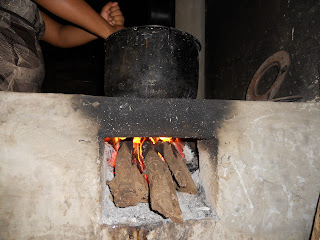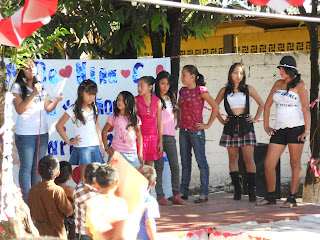The second week of February I had the marvelous opportunity to travel parts of Honduras with my Uncle Keith. As a Peace Corps volunteer in Honduras for three years and in Bolivia for one, he was here in Central America for a few weeks to reconnect with Peace Corps offices and spend a little time in his old volunteer site. I took a bus to Tegucigalpa to meet him in Hotel Honduras Maya, where he and his buddies used to go to enjoy a taste of Western amenities. I now feel like part of the club—I spent an embarrassingly long time in that hot shower.
 |
| The Hotel Honduras Maya |
 |
| The view of Tegucigalpa from our hotel room window |
Our trip began by waiting for each other for two hours in separate areas of the hotel. In a hilarious elevator debacle, I took one down to the lobby to wait and at the exact moment he took the other up to the room. After finally discovering him in the hotel restaurant, we took a stroll around Central Park and then were off to watch the Super Bowl! Dutifully decked out in our Packer gear, we cheered our team on to be CHAMPIONS! It was an exciting moment for us; unfortunately, there were no other gringos in sight to appreciate our triumph, but I believe the Hondurans were bemused by our enthusiasm.
 |
| GO PACK GO! |
The next morning, after I gorged on more food at the hotel’s fantastic continental breakfast than I probably ate in the last week, we were off to visit an old friend who owns a travel agency, and afterwards, to the Peace Corps office. There, we met one of Aunt Ana’s old friends from Peace Corps who was still working there! From what we gathered, Peace Corps is in a bit of turmoil right now as it is being forced to downsize and restructure due to budget cuts. Many countries must cut at least two programs, which is difficult both for the countries and the volunteers in those programs.
That afternoon, we toured two charming towns outside of Tegucigalpa in search of Uncle Keith’s old Peace Corps training center. Unfortunately, a lot had changed in 23 years, and it remained elusive. Apart from a few comments of, “Hmm, that wall looks familiar,” or, “I think I remember walking downhill,” we were at a loss, both for memory and for the training center (Sorry Uncle Keith, but that was too comical not to document)!
 |
| Central Park in Valle de Angeles |
 |
| Santa Lucia |
 |
| Wall full of Napoleon flowers in Santa Lucia |
The next day, we were off to Siguatepeque, where Uncle Keith lived as a Peace Corps volunteer working with a vegetable co-op named Cohorsil. The co-op allowed farmers to buy things together, for example fertilizer, to achieve a lower individual cost, as well as gave out reasonable loans (the interest rates in most banks here are 20-30%). After taking a tour of the town, we ventured off to the land Uncle Keith and Aunt Ana bought when they were in the Peace Corps (and perhaps the site of their future home). Their neighbors work as potters, and I got a sneak peak at the process of spinning clay, burning the pots, and painting the finished product. They sell their wares to “coyotes” who in turn sell them all over the country. Here’s a little taste of injustice for you: they get $5 for a pot (think about the costs of paying for clay, paying for the clay to be cleaned, and for all of their labor), and the coyote sells it for $35 to foreigners. One thing they have done (at Aunt Ana’s brilliant suggestion) is to create a catalogue of products that they can offer to buyers, so they don’t have to cart around tons of pots that might not be purchased.
 |
| Central Park in Siguaqtepeque |
 |
| Uncle Keith and Aunt Ana's old house |
 |
| Uncle Keith and Cebin, potter extraordinaire |
The next morning, we were both wide awake at 5am due to the apparent docking of a rooster pirate ship nearby. You may laugh…but it was true. We were serenaded for over an hour and a half with roosters cock-a-doodle-doing up a storm, accompanied by intermittent booms reminiscent of cannons (despite our persistent inquiries about these booms, we never found out what they were). So, we took advantage of our early start and ventured off to visit Chimino, a farmer with whom Uncle Keith used to work. What a surprise to have us pop up on their doorstep! But their hospitality was so warm and it was neat to watch everyone catch up on the last few years of life.
 |
| Roosters...everywhere. This is the "wall" between our hotel hallway and the neighbors. |
 |
| Posing with Chimino and his family |
Next up: find the mythical terraces on which Uncle Keith worked while he was in Siguatepeque. I say “mythical” only because after an hour of traipsing through a mountain-side of coffee plants, I was sure it was going to turn into a “training center” episode. (And for all the Cranes out there—just picture climbing Mill Bluff, but in 90 degree weather). Finally, we stumbled across the most beautiful (albeit the only) terraces I have ever step foot on!! How impressive to see that they were still there after all these years—a surreal experience to picture Uncle Keith working with Honduran farmers on that mountain, little by little teaching and improving agricultural practices.
 |
| "Over there" somewhere are the terraces |
 |
| Coffee plants |
 |
| Ripe coffee berries |
 |
| The mythical terraces, at last! |
Whereas Cohorsil used to work with vegetables, now they strictly plant coffee. They’ve even built a processing center there in the mountains, and we had the opportunity to take a personal tour! Coffee pickers bring it in by the sack, whereupon the co-op decides its quality based upon the color of the berries. The ripe coffee is red (I had no idea!), the green is not. Next the twigs and debris are sorted out, and the bean is extracted from the berry. The beans are washed, and then moved along a trough to be shoveled onto concrete slabs in order to dry. After it’s dry, the coffee is shelled. Until roasted (usually in the States), it remains a dull green-brown color (and doesn’t smell at all like coffee as we know it).
 |
| Cohorsil building |
 |
| Machine that removes the beans from the fruit and funnels them into a tank to be washed |
 |
| Coffee beans being laid out to dry |
 |
| 1. Original berry (used to be red until it dried), 2. Bean extracted from the berry, 3. Shelled bean awaiting roasting |
That afternoon, we rediscovered our green thumbs and got to work planting a few trees on Uncle Keith’s land. It’s a small plot with an astonishing variety of trees—orange, lemon, grapefruit, mahogany, pine—and now palm and cedro!
 |
| View of the land from the road |
 |
| Operation palm tree |
The last stop was a day at the Mayan ruins in Copan. Guatemala is home to most of the Mayan empire, but there was one grand city built in Honduras. The ruins were severely lacking in any information about most anything, save for an ill-defined map and a few signs. The true experience was to serenely sit back and imagine oneself amidst the hustle and bustle of one of the world’s greatest civilizations. Copan was such a beautiful and tranquil place to be—no roosters, no trucks, no buses, no fighting dogs. Only the pleasant twitter of birds and lingering voices of the few other tourists there. One of the most interesting things we learned is that it was Mayan custom to build over the last ruler’s buildings—so many of the structures housed at least nine others below it, still in the process of being discovered. Much of the ruins have been removed to a museum, so it was a constant guessing game as to whether what we were looking at was real. Furthermore, it was clear that many of the carvings remained in the original, enigmatic piles in which they were discovered, as piecing together the hieroglyphics and structures has proved quite a challenge.
 |
| Map of the Mayan Empire |
 |
| Bird's eye view of the city |
 |
| Beautiful macaws...right before one almost flew into my head |
 |
| The ever-elusive watusa rodent |
 |
| Uncle Keith and various stelae in the Great Plaza |
 |
| Another set of stelae |
 |
| Mayan ball court--the second largest in Central America |
 |
| Residential area for rich community members |
 |
| Rear view of the Acropolis |
 |
| A temple--built upon nine other temples |
 |
| Giant Mayan guy |
 |
| A view of the Great Plaza |
 |
| Famous stairway that tells the story of the royal house in Copan--scientists are still trying to reassemble the steps in order to be able to read the hieroglyphics. |
The next day we returned to Guatemala, spending a brief night in Antigua.
 |
| Antigua's famous arch |
 |
| Naturally world champions like the Packers would be revered by other countries too |
The next day we returned to Santo Domingo just in time for Valentine’s Day, which is another story to tell. The week absolutely flew by, but it was such a pleasure to be able to explore another country and to relive a different kind of volunteer experience. Our days were full of good stories, riotous laughter, meaningful discussions, and quiet reflection. It was an opportunity for me to gain perspective on my experiences here in Guatemala, both good and bad, and for that I am so happy and grateful. Another round of heartfelt thanks goes out to Uncle Keith for the fantastic week we enjoyed!


























































